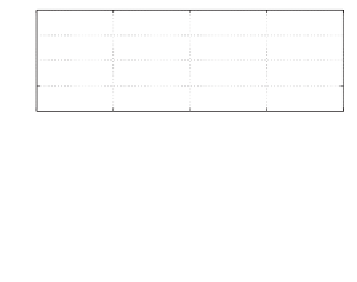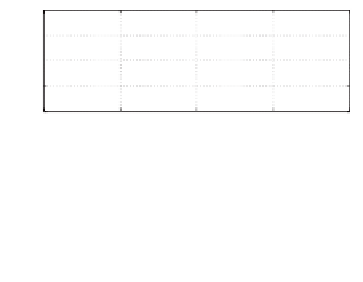Environmental Engineering Reference
In-Depth Information
4
30
i
ref
i
a
u
ref
u
A
2
15
0
0
−2
−15
−4
−30
2
4
e
i
e
u
1
2
0
0
−1
−2
−2
−4
6.88
6.98
7.08
7.18
7.28
6.88
6.98
7.08
7.18
7.28
Time [s]
Time [s]
(a)
i
a
, its reference
i
ref
and the error
e
i
(b)
u
A
, its reference
u
ref
and the error
e
u
Figure 6.22
Detailed responses when transferred from the grid-connected mode to the stand-alone
mode at
t
=
7
.
08 s
dynamics in the current. There was no noticeable change in the inverter local load voltage,
either. Hence, seamless grid connection was achieved.
A step change in the grid current reference
I
d
from0Ato1
.
5A(1
.
06 A RMS) was applied
at time
t
3 s and the responses are shown in Figure 6.21. The system took about 12 cycles
to settle down, which is consistent with the test done in Section 6.6.3.1.
At
t
=
08 s, the inverter was disconnected from the grid and the details of the responses
are shown in Figure 6.22(a) and (b). There was no noticeable transients in the inverter local
load voltage and seamless disconnection from the grid was achieved.
In summary, the control strategy is able to achieve seamless transfer of operation modes
from stand-alone to grid-connected or vice versa.
=
7
.
6.7 Summary
Based on (Hornik and Zhong 2010a; Zhong and Hornik 2012), a cascaded current-voltage
control strategy is presented for inverters in microgrids. It consists of an inner voltage loop and
an outer current loop and offers excellent performance in terms of THD for both the inverter
local load voltage and the grid current. In particular, when non-linear and/or unbalanced
loads are connected to the inverter in the grid-connected mode, this strategy significantly
improves the THD of the inverter local load voltage and the grid current at the same time.
The controllers are designed using the
H
∞
repetitive control but can be designed with other
approaches as well. This strategy also achieves seamless transfer between the stand-alone mode
and the grid-connected mode. It can be used for both single-phase systems and three-phase
systems. As a result, non-linear harmonic currents and unbalanced local load currents are all
contained locally and do not affect the grid. Experimental results under various scenarios are
presented to demonstrate the performance.


































Search WWH ::

Custom Search